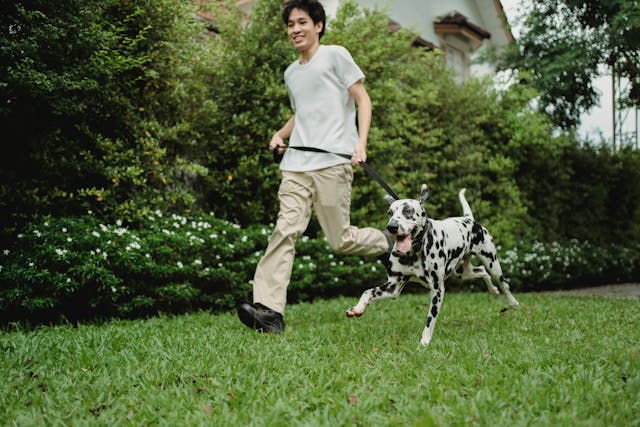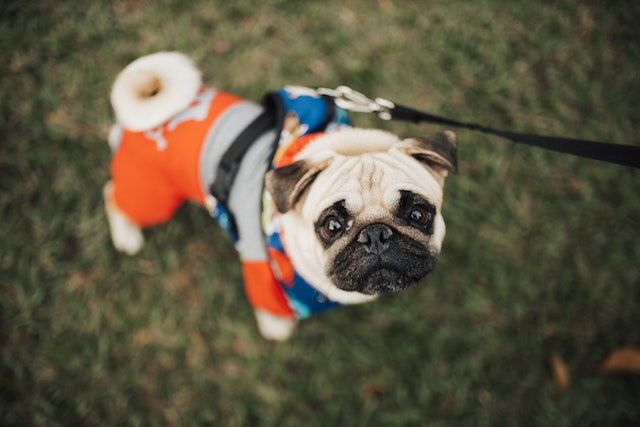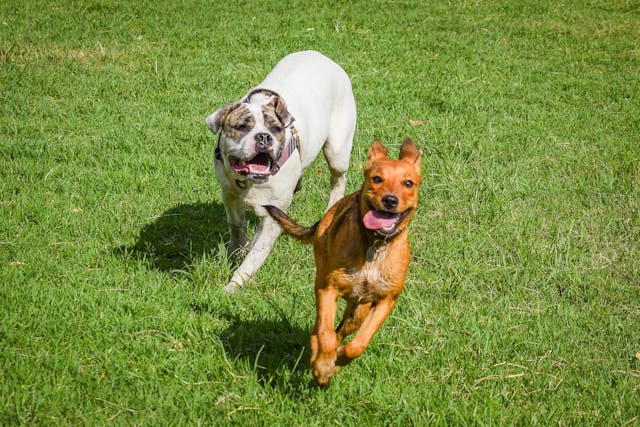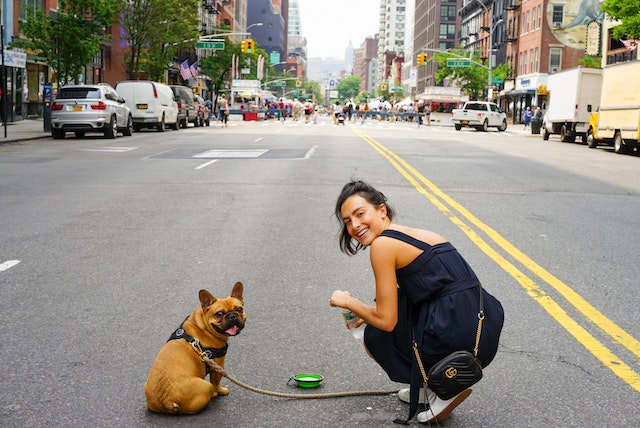How Much Exercise Does My Dog Need?
Posted: 02/18/2025 | BY: Jenna Bruce | Categories: Dog , Pet care , Top Tips
If dogs could talk, they’d probably tell us they love two things: food and fun. And for most dogs, fun equals exercise! Whether it’s zooming around the yard, chasing a ball, or going on a long, sniff-filled walk, exercise is essential for keeping your pup happy and healthy. But you may be wondering, “How much exercise does my dog need?” And is there such a thing as too much exercise? Let’s break it down so you can create the perfect workout plan for your furry friend!

Why Does Exercise Matter?
Before we dive into how much exercise your dog needs, let’s talk about why it’s so important. Regular exercise helps your dog:
- Maintain a healthy weight (goodbye, extra treats hanging around the waistline!).
- Strengthen muscles and joints, preventing injuries and arthritis.
- Reduce behavioral issues—tired dogs are less likely to destroy your sofa or dig up the backyard!
- Improve mental stimulation and prevent boredom.
- Strengthen the bond between you and your pup (who doesn’t love quality time?).
- Support cardiovascular health, ensuring a strong heart and better endurance.
- Enhance digestion and metabolism, helping with overall well-being.
Factors That Determine Exercise Needs
Now let’s get down to the nitty-gritty…
Every dog is different, and their exercise needs depend on several factors:
1. Breed
Some breeds were made to be couch potatoes, while others were born to run marathons. Here’s a rough guide based on breed types:
- High-energy breeds (Border Collies, Australian Shepherds, Labrador Retrievers, Siberian Huskies) need at least 1-2 hours of intense exercise per day.
- Moderate-energy breeds (Golden Retrievers, Cocker Spaniels, Poodles) do well with 45 minutes to 1.5 hours of exercise daily.
- Low-energy breeds (Bulldogs, Basset Hounds, Shih Tzus) often prefer 20-40 minutes of light exercise each day.
If you’re unsure of your dog’s specific exercise needs, ask your vet what they recommend.
2. Age
- Puppies have bursts of energy but tire quickly. Short, frequent play sessions (5-10 minutes several times a day) work best. Over-exercising a puppy can be harmful to developing joints, so be mindful of their limits.
- Adult dogs typically need structured daily exercise based on their breed and energy level.
- Senior dogs still need movement but at a gentler pace. Think slow walks and light play for 20-45 minutes a day, depending on their health. Swimming is also a great, low-impact option for older dogs.
3. General Health
Dogs with arthritis, heart conditions, or other health concerns may need adjusted exercise routines. Always check with your vet before making changes. Some dogs may benefit from physical therapy or hydrotherapy to stay active without straining their joints.
How to Exercise Your Dog Based on Their Needs
For High-Energy Breeds
High-energy pups need plenty of action to burn off their endless energy! Try:
- Long hikes – Let them explore nature’s playground.
- Running or biking together – A great way to keep up with their stamina.
- Agility training – Keeps their body and brain engaged.
- Dog sports like flyball or dock diving – Perfect for competitive canines.
- Off-leash play in a secure area – They’ll love sprinting to their heart’s content.
- Frisbee games – A fun challenge that engages their athletic abilities.

For Moderate-Energy Breeds
These dogs enjoy a mix of activity and downtime. Try:
- Daily walks (45-60 minutes total) – Perfect for keeping them fit.
- Playtime at the dog park – Great for socialization and exercise.
- Fetch or tug-of-war – Keeps them engaged and moving.
- Obedience training sessions – Mental workouts count, too!
- Nose work games – Hiding treats around the house keeps them busy.
For Low-Energy Breeds
These dogs still need movement, just in smaller doses. Try:
- Short, gentle walks (20-30 minutes a day).
- Indoor games like hide-and-seek with treats.
- Puzzle toys – Mental exercise is just as important!
- Swimming (if they enjoy it) – Low impact and easy on the joints.
- Slow-paced trick training – Keeps them engaged without over-exertion.
Signs Your Dog Needs More (or Less) Exercise
Dogs can’t tell us in words, but they sure have ways of showing when they need a change in their exercise routine!
Signs Your Dog Needs MORE Exercise:
- Destructive behavior (chewing, digging, barking excessively)
- Hyperactivity, even after a walk
- Weight gain
- Attention-seeking behaviors
- Jumping or over-excitement when you pick up the leash
Signs Your Dog Needs LESS Exercise:
- Limping or stiffness after activity
- Excessive panting or struggling to keep up
- Reluctance to go on walks
- Sleeping more than usual
- Disinterest in playtime or socialization
Making Exercise Fun for Both of You
Exercise isn’t just good for your dog—it’s great for you, too! Here are some ways to keep it fun and engaging:
- Try new walking routes – Keeps things interesting for both of you. New routes allow the both of you to see (and smell) new things!
- Play interactive games – Use a flirt pole, hide-and-seek, or obstacle courses.
- Schedule doggy playdates – Socialization + exercise = happy dog!
- Train while exercising – Practice commands during walks or runs.
- Incorporate rewards – A little treat or praise makes activities more exciting.
- Rotate activities – Switching up games and routines keeps them engaged.
- Join a dog-friendly fitness class – Some communities offer group workouts for dogs and owners!
The Bottom Line
Exercise isn’t one-size-fits-all for dogs, and their needs will change over time. Pay attention to your pup’s behavior and adjust their routine accordingly. The key is to keep them active, engaged, and happy—whether that means epic hiking adventures or a cozy walk around the block.
Protect Your Pup’s Health
No matter how much exercise your dog gets, accidents and health issues can still happen. Pet insurance helps cover unexpected vet bills so your furry friend gets the best care possible. Consider enrolling in a plan today for peace of mind and a lifetime of tail wags!
Not sure where to start? Here are the top pet insurance providers – in order – based on over 180,000 authentic reviews from pet parents just like you:
Top Pet Insurance Providers of 2025
| Rating | Provider | Total Review |
|---|---|---|
| 4.9 | Embrace | 18,347 |
| 4.9 | Healthy Paws | 10,168 |
| 4.9 | Trupanion | 60,888 |
| 4.9 | Fetch | 26,289 |
| 4.9 | Lemonade | 809 |
| 4.8 | Nationwide | 21,410 |
| 4.8 | Prudent Pet | 1,759 |
| 4.7 | Pumpkin | 1,680 |
| 4.6 | Hartville | 169 |
| 4.6 | ManyPets | 2,381 |
| 4.6 | Spot | 7,945 |
| 4.5 | ASPCA | 11,869 |
| 4.5 | PetPartners | 115 |
| 4.4 | AKC | 893 |
| 4.3 | Pets Best | 12,845 |
| 4.2 | Figo | 2,615 |
| 4.0 | Pet Assure | 13 |
| 3.9 | MetLife | 730 |
References:
- https://www.akc.org/expert-advice/health/how-much-exercise-does-dog-need/
- https://www.pdsa.org.uk/pet-help-and-advice/looking-after-your-pet/puppies-dogs/how-much-exercise-does-your-dog-need
- https://www.petmd.com/dog/wellness/evr_dg_exercising_with_your_dog101
Disclaimer
The information contained on this blog is intended for informational and educational purposes only and should not be construed as medical advice. It is not a substitute for professional veterinary care. Always consult with your veterinarian before making any changes to your pet's health care or treatment plan.
The authors of this blog are not veterinarians and do not claim to be experts in pet health. The information provided here is based on our own experiences and research, as well as information from reputable sources. However, we cannot guarantee the accuracy or completeness of this information.
We encourage you to do your own research and consult with your veterinarian before making any decisions about your pet's health.
Previous post
Pyoderma in Dogs: What You Need to KnowNext post
The 10 Most Popular Cat BreedsCompare top pet insurance providers & plans.
Enter your dog’s age in years and months to calculate their age equivalent to human years.
Calculate your dog’s ageEnter your cat’s age in years and months to calculate their age equivalent to human years.
Calculate your cat’s age

